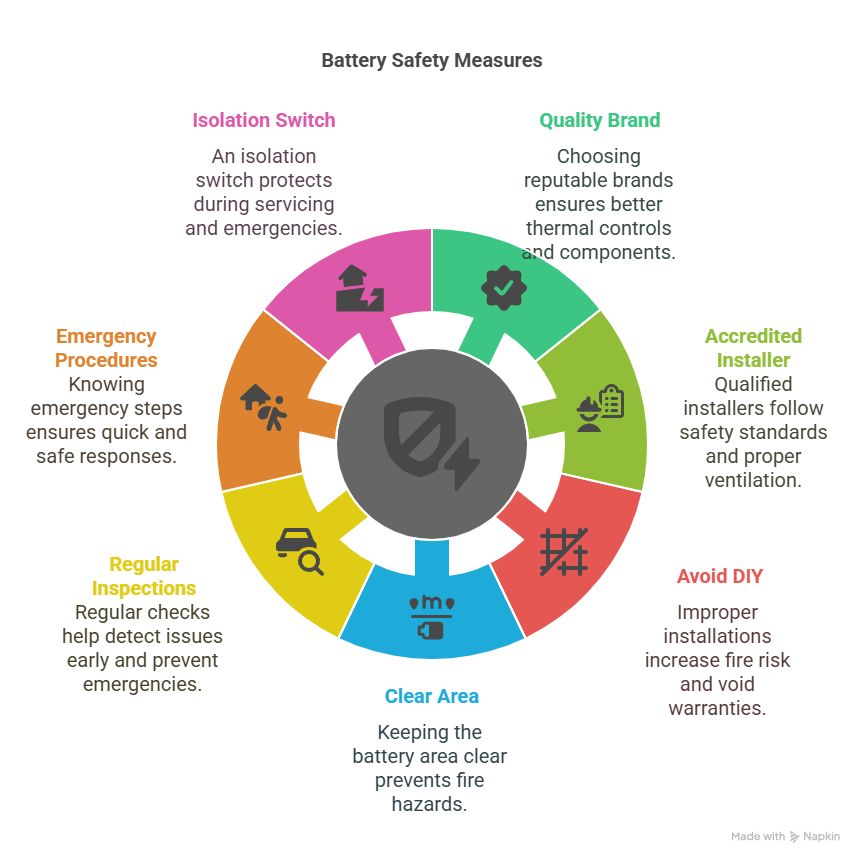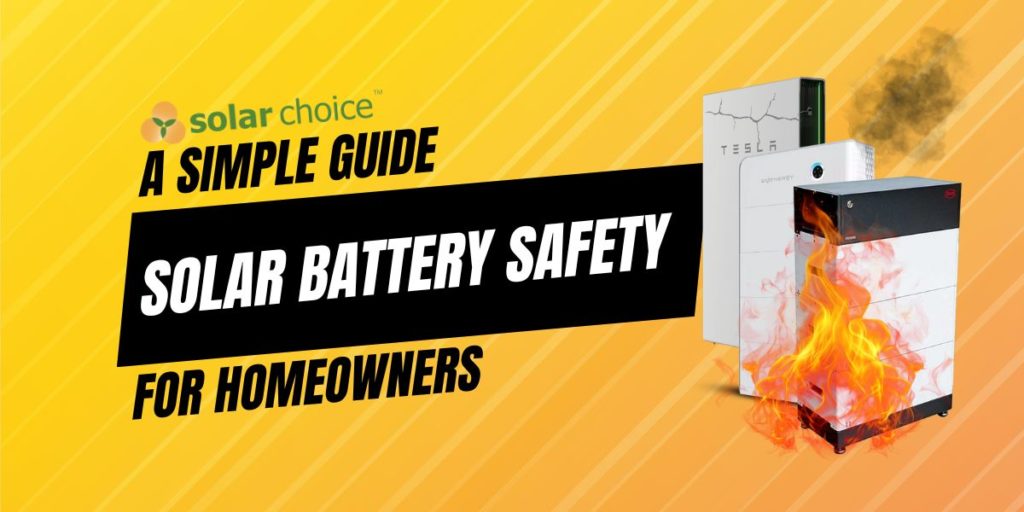Are Solar Batteries Safe?
Yes — solar batteries are generally safe when installed correctly by Clean Energy Council (CEC) accredited professionals. Australian standards ensure systems are built and installed to minimise risks. But like any electrical equipment, there are safety considerations.
Quick Takeaways
- Batteries are safe when installed and maintained correctly, according to data from the Australian Competition and Consumer Commission (ACCC), which has tracked only a small number of incidents despite over 200,000 units installed nationwide.
- Recalls have occurred — especially LG Chem units from 2017–2018
- Use a CEC-accredited installer
- Choose reputable brands with Australian support
- Keep the area around your battery clean and ventilated
Compare solar and battery quotes online now.
Understanding Fire Risks: What the ACCC Warned About
In 2022, the ACCC warned consumers about fire risks linked to some LG solar batteries. More than 7,500 batteries were recalled across several brands:
- LG Chem (RESU series)
- SolaX
- Opal
- Redback
- Red Earth
- Eguana
- VARTA
Issue: Some lithium-ion batteries manufactured between March 2017 and September 2018 had cell defects. These could lead to “thermal runaway” — where the battery overheats or catches fire.
Reported Incidents in Australia (2019–2022):
- 9 battery fires
- 1 injury
- Over 2,900 batteries replaced
What You Should Do
- Check your battery’s serial number using the LG Recall Checker
- Turn off the system if affected and contact the manufacturer
- Arrange a replacement or refund — these are offered free of charge
Why Modern Batteries Are Safer
Batteries made after 2020 are safer due to:
- More stable lithium chemistries like LiFePO₄
- Battery Management Systems (BMS) to prevent overheating
- AS/NZS 5139 installation standards
- Built-in thermal protection and shutdown features
More than 200,000 solar batteries are in use across Australia, with very few safety issues.
Battery Design, IP Ratings & Why Enclosure Matters
For outdoor or indoor safety, your battery’s enclosure must meet strict durability and weatherproofing standards:
- Outdoor installations must be rated at least IP23 (resistant to rain and dust).
- Indoor units require a minimum of IP2X for basic touch and object protection.
- External battery casings should be:
- Metallic (min. 0.2mm thick) or
- Fire-rated plastic (classified as 5VA)
Always check your battery’s nameplate or spec sheet to ensure it complies with these ratings. If labels are faded or unclear, contact your installer — legible safety labels are mandatory.
Advanced Safety Features You Can Ask For
While not required, these features add extra peace of mind:
- Fire-resistant casing (UL 1973 compliance)
- Local warning alarms for faults
- Remote monitoring via Wi-Fi/4G (non-essential to safety)
- Salt mist protection for coastal homes
- Wind-load rated mounts for wall installations
Ask your installer which of these are included in your system.
Battery Chemistry and Safety Comparison
| Battery Type | Safety Level | Notes |
| LiFePO₄ | Very High | Stable and widely used in modern home batteries |
| NMC | Moderate | High energy density, but needs a strong Battery Management System (BMS) to manage heat and charging safely. |
| LTO | Excellent | Long life, high safety, but more expensive and less common |
LiFePO₄ (Lithium Iron Phosphate): is the safest and most widely used battery chemistry in modern home systems. Its thermal stability and low fire risk make it the preferred choice for Australian households prioritising safety.
Learn more from Standards Australia and Product Safety Australia.
7 Ways to Maximise Battery Safety

1. Choose a Quality Brand
Brands with a long history and proven safety records are more likely to invest in robust thermal controls and quality components.
2. Use a CEC-Accredited Installer
A qualified installer will:
- Follow AS/NZS 5139
- Ensure proper ventilation
- Avoid risky placements near living areas
3. Don’t DIY or Use Unlicensed Installers
Improper installations may void your warranty and increase fire risk.
4. Keep the Battery Area Clear
- Avoid flammable items nearby
- Ensure the battery is dry, shaded, and ventilated
5. Schedule Regular Inspections
- Every 5 years minimum
- Watch for error codes or excess heat
6. Know What to Do in Emergencies
- Evacuate the home
- Call 000 immediately
- Do not try to fight the fire yourself
7. Install a Proper Isolation Switch
Every solar battery system should include an isolation device that disconnects both active and neutral (AC) or positive and negative (DC) lines. This protects homeowners and emergency responders during servicing or emergencies.
Ask your installer:
- Where your system’s manual shut-off switch is located
- How to operate it safely during faults or smoke incidents
Common Homeowner Mistakes to Avoid
Here are a few safety oversights many battery owners don’t know to avoid:
- Stacking items around or on top of the battery (blocks airflow)
- Installing near heaters or BBQs
- Using unapproved parts or battery combinations
- Letting safety labels fade or go missing
- Not performing a basic visual inspection every 6–12 months
Solar Battery Insurance: What You Should Know
Solar batteries are usually covered under your building insurance, not contents. However, coverage can vary significantly by provider — especially for systems with backup functionality.
To stay protected:
- Notify your insurer after installation
- Confirm the battery complies with AS/NZS 5139
- Request written confirmation that battery fire, damage, and replacement are covered
- Ask about premium discounts for sustainable home upgrades
To learn more, see guidance from the Insurance Council of Australia.
Request a Certificate of Electrical Compliance
After installation, ask your installer to provide a Certificate of Electrical Safety or Compliance. This document confirms the system was installed according to Australian standards (AS/NZS 5139) and helps:
- Validate your warranty
- Confirm eligibility for insurance claims
- Support resale value of your home
End-of-Life Safety and Recycling
Solar batteries last 10–15 years. When they’re no longer usable:
- Contact the manufacturer or installer
- Don’t dispose of them in regular household bins
- Use certified recycling or safe disposal options from your local council
Ask for Your Battery’s Safety Data Sheet (SDS)
Every solar battery should come with a Safety Data Sheet (SDS) explaining:
- Chemical hazards
- Emergency handling procedures
- Storage and disposal precautions
While not legally required in all cases, the best brands provide them upfront. It’s a smart way to stay informed and prepared.
Final Thoughts
Solar battery systems are safe and dependable when quality products are installed correctly. To stay protected:
- Buy from trusted brands
- Use licensed CEC-accredited installers
- Keep the area clear and clean
- Know how to respond in an emergency
Why it matters: Ensuring your battery is installed safely protects your home, your family, and your investment in clean energy.
By staying informed, your battery system can power your home safely for years.
FAQs: Solar Battery Safety
Are solar batteries a fire risk?
Yes. However the risk is very low with correct installation and regular maintenance.
Which battery type is safest?
LiFePO₄ batteries are the most thermally stable.
How do I check if my battery is recalled?
Check your serial number on the manufacturer’s website or visit productsafety.gov.au.
What causes solar battery fires?
Usually due to manufacturing defects or poor installation.
Can I install a battery indoors?
Only if the system is fire-rated and compliant with Australian standards. Most are installed outside or in garages.
Compare solar and battery quotes online now.
- Changes To Cheaper Home Batteries Program From 1 May 2026 | Homeowners Guide - 15 December, 2025
- ReadySteadyPlug EV Charging for Apartments: An Independent Review by Solar Choice - 12 December, 2025
- Everything Electric Melbourne | EV Battery Health, Street Charging & Smarter Homes - 27 November, 2025
